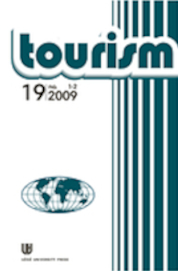Paradygmat terytorialności w turystyce kulturowej
DOI:
https://doi.org/10.18778/0867-5856.19.1-2.05Keywords:
turystyka kulturowa, spójność terytorialna, badania zasięgu oddziaływania, „turystyfikacja”, krajobrazy kulturoweAbstract
Typowe podejście geografów do turyzmu zakłada nacisk na analizę ruchu turystycznego w przestrzeni i sposoby korzystania z tej przestrzeni, jak również na syntezę spójności terytorialnej pomiędzy ludźmi, miejscem a produktem. Nowe zainteresowanie terytorialnymi aspektami turyzmu może być postrzegane z jednej strony jako reakcja na globalizację, a z drugiej jako poszukiwanie unikatowych, autentycznych i doświadczeń grass-rooted. W ostatnich badaniach centrum uwagi zostało przeniesione z opisu prawidłowości na analizę procesu zmian spowodowanych przez turyzm („turystyfikacja”). Zrozumienie sił, które przekształcają krajobrazy kulturowe (miejskie i wiejskie) w krajobrazy turystyczne jest podstawowym warunkiem wizjonerskiego planowania i odpowiedzialnego zarządzania regionami i miejscowościami. Artykuł zawiera kilka refleksji na temat przyszłych badań geoturystycznych.
Downloads
References
AGARWAL S, BALL R., SHAW G., WILLIAMS A., 2000, The geography of tourism production: uneven disciplinary development?, Tourism Geographies 2(3), pp. 241–263.
Google Scholar
DOI: https://doi.org/10.1080/14616680050082517
AITCHISON C., MACLEOD N.E., SHAW, S. J., 2000, Leisure and tourism landscapes: social and cultural geographies, Routledge, London
Google Scholar
BRIEDENHANN J., WICKENS E., 2004, Tourism routes as tool for economic development of rural areas: Vibrant hope or impossible dream?, Tourism Management, 25(1), pp. 71–79.
Google Scholar
DOI: https://doi.org/10.1016/S0261-5177(03)00063-3
BUTLER R., WOLDBROOTZ L., 1991, A New Planning Tool: Tourist Opportunity Spectrum, The Journal of Tourism Studies 2(1), pp. 2–14.
Google Scholar
BUTLER R.W. (ed.), 2006, The tourism area life cycle. Vol. 2: Conceptual and theoretical issues, Channel View Publication, Clevedon, UK.
Google Scholar
DOI: https://doi.org/10.21832/9781845410308
DE HAAN H., VAN DER DUIM R. (eds), 2008, Landscape, Leisure and Tourism, Eburo: Delft.
Google Scholar
ESPON, 2006, The role and spatial effects of cultural heritage and identity (2004-2006), Final Report Project 1.3.3. EU Luxemburg.
Google Scholar
GRAVARI-BARBAS M. & P. VIOLIER (eds), 2003, Lieux de culture et culture des lieux; production(s) culturele(s) locale(s) et émergence des lieux: dynamiques, acteurs, enjeux, PUR, Rennes.
Google Scholar
HALL D., SMITH M., MARCISZEWSKA B. (eds), 2006, Tourism in the New Europe. The Challenges and Opportunities of EU Enlargement, CAB International, Wallingford.
Google Scholar
DOI: https://doi.org/10.1079/9781845931179.0000
HOWARD P. 2004, Spatial planning for landscape: Managing the pitfalls, Landscape Research 29(4), pp. 423–434.
Google Scholar
DOI: https://doi.org/10.1080/0142639042000289055
JANSEN-VERBEKE M., 2007, Cultural resources and the tourismification of territories, Acta Turistica Nova, 1(1), pp. 21–41.
Google Scholar
JANSEN-VERBEKE M., PRIESTLEY G.K., RUSSO A.P. (eds), 2008, Cultural Resources for Tourism: Patterns, Process and Policies, Nova Science, New York.
Google Scholar
JANSEN-VERBEKE M., 2008, A Geographer’s Gaze at Tourism, Documents d'Anàlisi Geogràfica, 52 (2), pp. 15–29.
Google Scholar
JANSEN-VERBEKE M., 2009, Territorial embedding of intangible heritage and cultural tourism, [in:] Sharing Cultures- International Conference in Intangible Heritage – Conference Proceedings, Green Line Institute – Azores – Portugal (in press)
Google Scholar
LEW A., HALL, M., TIMOTHY, D., 2008, World Geography of Travel and Tourism – A regional approach, Butterworth Heinemann Oxford.
Google Scholar
LEW A, HALL, M., WILLIAMS A. (eds), 2004, A companion to tourism, Blackwell Publishing, Oxford.
Google Scholar
DOI: https://doi.org/10.1002/9780470752272
METZ T. 2002, Fun! Leisure and landscape, NAI Publishers, Rotterdam
Google Scholar
RICHARDS G, WILSON J., 2006, Developing creativity in tourist experiences: A solution to serial reproduction of culture?, Tourism Management, 27, pp. 1209–1223.
Google Scholar
DOI: https://doi.org/10.1016/j.tourman.2005.06.002
RIEUCAU J., LAGEISTE J. (eds), 2006, L’empreinte du tourisme; Contribution à l’identité du fait touristiques, L’Harmattan, Paris.
Google Scholar
ROMAGOS A.F., RUSSO A.P. 2008, The advantages of sharing : A case study of the Jewish Heritage Network in Spain, [in:] Jansen-Verbeke, M., Priestley G.K., Russo, A.P. (eds), 2008, Cultural Resources for Tourism: Patterns, Process and Policies, Nova Science, New York, pp. 59–78.
Google Scholar
RUSSO A.P., SEGRE G., 2009, Destinations and property regimes: an exploration, (accepted for publication – March 2009) in Annals of Tourism Research.
Google Scholar
DOI: https://doi.org/10.1016/j.annals.2009.04.002
SANTAGATA W., RUSSO A.P., SEGRE G., 2008, Tourist quality labels: An incentive for the sustainable development of creative clusters as tourist attractions? [in:] Richard, G. Wilson, J. (eds), Tourism, Creativity and Development, ATLAS, Arnhem.
Google Scholar
STEINECKE A., 2007, Kulturtourismus, Oldenbourg Verlag, Munchen –Wien.
Google Scholar
DOI: https://doi.org/10.1524/9783486711165
SUN Y., MIN Q., JANSEN-VERBEKE M., CHENG S., 2009, Agricultural Heritage Systems: A case study in Longxian village on conservation and tourism (Southern China), Tourism Geographies (submitted).
Google Scholar
VAN DER DUIM R. 2007, Tourismscapes: An actor-network perspective, Annals of Tourism Research, 34(4), pp. 961–976.
Google Scholar
DOI: https://doi.org/10.1016/j.annals.2007.05.008
Downloads
Published
How to Cite
Issue
Section
License

This work is licensed under a Creative Commons Attribution-NonCommercial-NoDerivatives 4.0 International License.










